| qualitas1998.net
|
FineCat 2017: Great symposium at Royal Palace
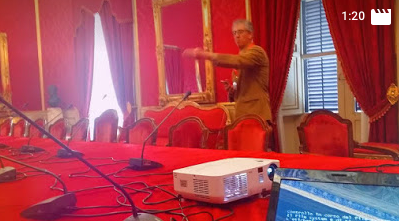 Jointly organized by Italy's Research Council and Palermo's University, the 6th edition of the “FineCat - Symposium on
heterogeneous catalysis for fine chemicals” was held in Sicily's
Royal Palace in Palermo on April 5th (watch the
photogallery).
Jointly organized by Italy's Research Council and Palermo's University, the 6th edition of the “FineCat - Symposium on
heterogeneous catalysis for fine chemicals” was held in Sicily's
Royal Palace in Palermo on April 5th (watch the
photogallery). The Palace is the oldest royal residence in Europe. It was the seat of the Kings of Sicily during the Norman domination and has served ever since as the main seat of power for all rulers of Sicily, up to becoming (in 1947) Seat of the Sicilian Parliament.
In his words of greeting Hon. Giampiero Trizzino emphasized the importance to host an high-level meeting in clean technology in Sicily's Parliament because, he explained, tomorrow's Sicily will be known for its practical achievements in clean technology, renewable energy and new production routes based on the circular bioeconomy principles.
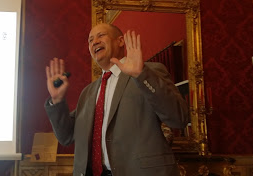 The scientific works (watch the video) were opened by Gideon Grader, professor of chemical engineering at Haifa's Technion where he leads
the University's energy program for which, for example, his doctoral student Landman recently won the Three Minute Thesis competition in Australia.
The scientific works (watch the video) were opened by Gideon Grader, professor of chemical engineering at Haifa's Technion where he leads
the University's energy program for which, for example, his doctoral student Landman recently won the Three Minute Thesis competition in Australia.In an inspirational lecture he discussed the mechanisms discovered by his Group to create the unique mesoporous core-shell architecture of nanostructured materials with multifunctional, specific properties - an highly desirable finding which facilitates new possibilities and applications in all fields of catalysis due to the combination of high surface to volume ratio and low mass transfer resistance to and from the catalytic sites.
In closer detail, Professor Grader showed how to synthesize ceramic nanofibers with unique core-shell structure, consisting of an inner mesoporous Fe-Al-O core with an outer Fe-rich shell, using electrospinning followed by controlled thermal treatment. A general mechanism of core and shell formation has been outlined and confirmed by his team for which, depending on heating rates, unique mesoporous nanofibers with or without shell are obtained.
After the coffee-break, Heidelberg University's organic chemistry professor A. Stephen K. Hashmi, gave a fascinating lecture on new aspects of gold catalysis applied to the synthesis of a variety of functional products. Professor Hashmi, who is also vice rector for research at Heidelberg University, described the latest findings concerning the new synthetic methods to access both gold(I) and gold(III) catalytic species, the identification of highly reactive catalysts, and the development of gold-catalyzed reactions including additions to allenes and alkenes, benzannulations, cycloisomerization, rearrangement as well as oxidation and reduction reactions.
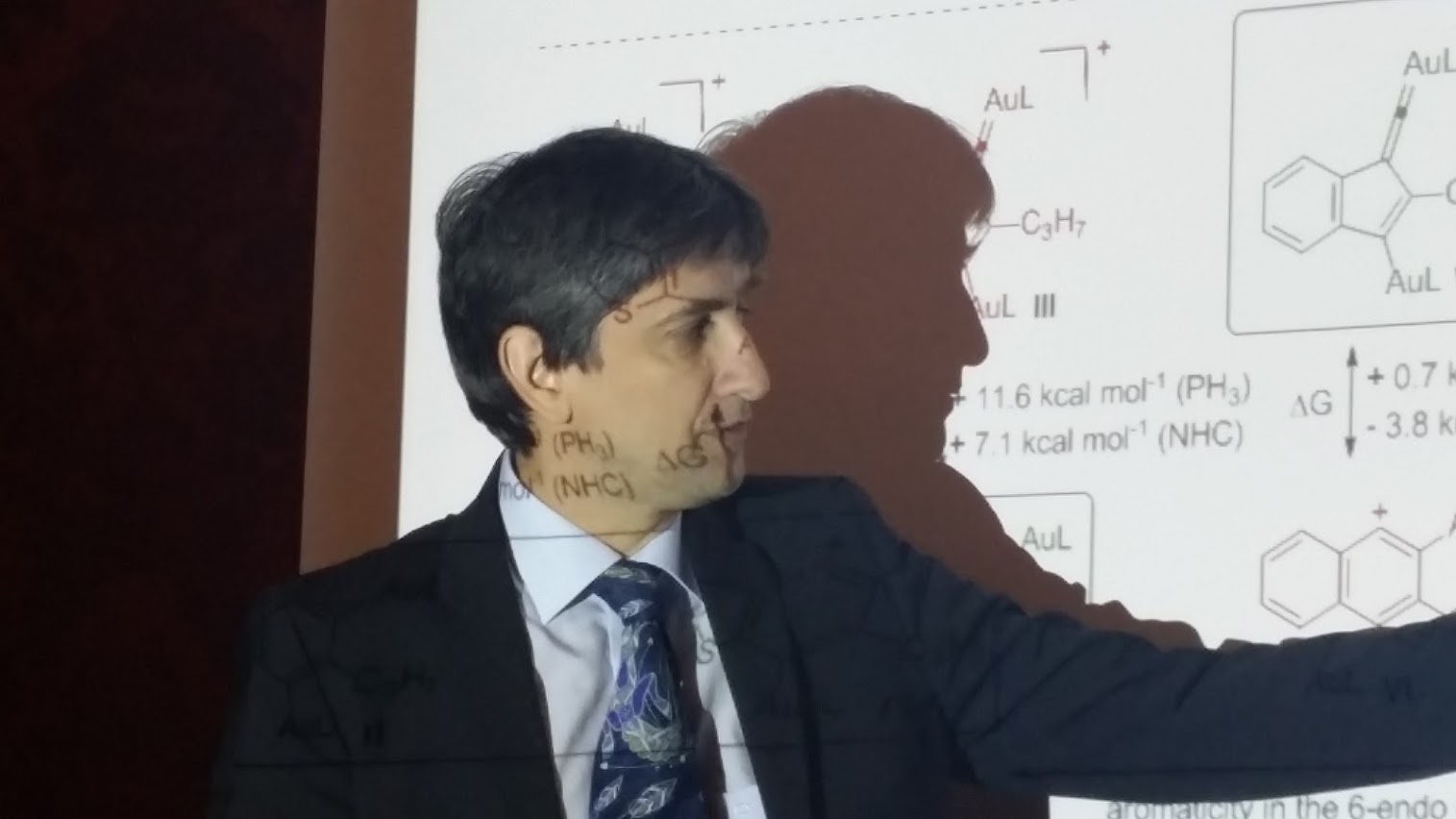 "I can tell you" he answered a question on practical applications in the pharmaceutical and fine chemical industries, "that
when I meet industrial researchers, usually at their production sites,
they make questions as if they were using and studying gold catalysis
since years".
"I can tell you" he answered a question on practical applications in the pharmaceutical and fine chemical industries, "that
when I meet industrial researchers, usually at their production sites,
they make questions as if they were using and studying gold catalysis
since years". Already used for the production of bulk chemicals, gold catalysis is poised to be introduced in the production of the basic ingredients of a wide variety of valued added products ranging from pharmaceuticals through liquid crystals and organic light emitting diodes (OLED) for computer, TV and mobile phone screens.
Professor Raed Abu-Reziq, The Hebrew University of Jerusalem, Israel, presented the results of his team concerning the development of new nanostructured materials, nano-and microreactors as platforms for heterogeneous catalysis. He showed how advanced sol-gel processing nanochemistry can be used to encapsulate, for example, ionic liquids and convert them from liquid to solid state.
Catalytic microreactors, he explained, have a potential to bridge between homogeneous and heterogeneous catalysis by the microencapsulation of catalyst dissolved or dispersed in non-volatile phase such as a ionic liquid.
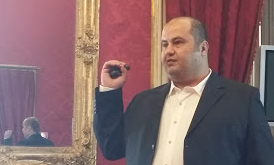 The
microcapsules can be constructed in two steps: emulsification of the
non-volatile phase in water or organic solvents and interfacial
polycondensation of silane monomers. In addition, Professor Abu-Reziq
described the preparation and use of different magnetically separable nano-supports and their utilization in the supporting of different catalysts.
The
microcapsules can be constructed in two steps: emulsification of the
non-volatile phase in water or organic solvents and interfacial
polycondensation of silane monomers. In addition, Professor Abu-Reziq
described the preparation and use of different magnetically separable nano-supports and their utilization in the supporting of different catalysts. He continued to show impressive results -- some of which not yet published and thus due to appear shortly in the international literature -- in important reactions including C-C bond formation and stereoselective hydrogenations.
Francesco Parrino, a post-doctoral researcher in the “Schiavello-Grillone” research Group of Palermo's University, presented the new results obtained in photocatalytic bromine synthesis. An eco-friendly and economic process capable to replace current industrial production via oxidation of bromide ions using gaseous chlorine is highly desirable, he explained opening his presentation.
Hence, he showed how significant production (85% selectivity) of elemental bromine was observed for the first time when irradiating with UV light a bromide containing solution at acidic pH in the presence of commercial (P25) TiO2 ozone, or a combination thereof.
The process is general and may be readily applied at a laboratory scale for green bromination reactions. Lately published in Angewandte, the process has also been patented as a safe and environmentally sustainable alternative production methods.
Giuseppe Bagnato, a PhD student at Heriot-Watt University, United Kingdom, presented six posters mainly in the field of catalytic membrane reactor technology which he is now working to integrate in the biorefinery.
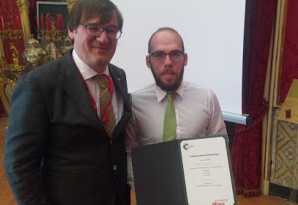 His
poster entitled "Hydrogenation of Bio-Oil: A Thermodynamic Study " was
awarded the best poster presentation prize - an online subscription to Catalysis Science & Technology,
the RSC flagship catalysis journal with which the organisers of FineCat
have partnered since the first edition of the Symposium in 2012.
His
poster entitled "Hydrogenation of Bio-Oil: A Thermodynamic Study " was
awarded the best poster presentation prize - an online subscription to Catalysis Science & Technology,
the RSC flagship catalysis journal with which the organisers of FineCat
have partnered since the first edition of the Symposium in 2012. Giuseppe was presented with a certificate signed by the journal's Executive Editor, Anna Simpson.
After the works, the delegates were guided to an impressive tour of the Royal Palace kindly offered by the Federico II Foundation.
The 7th edition of FineCat will be held in Sicily on April 8, 2018.
Back to the FineCat Symposium Home-Page